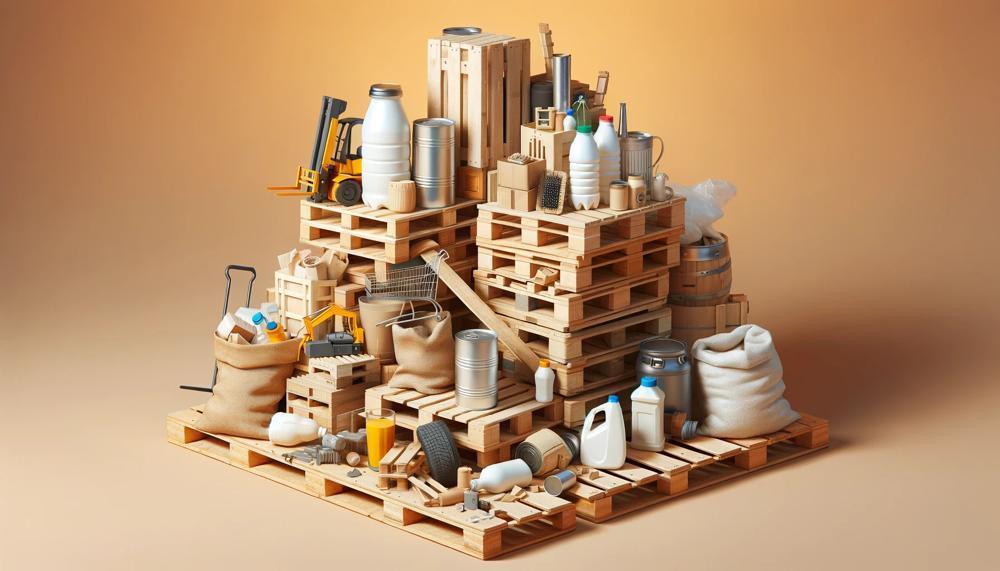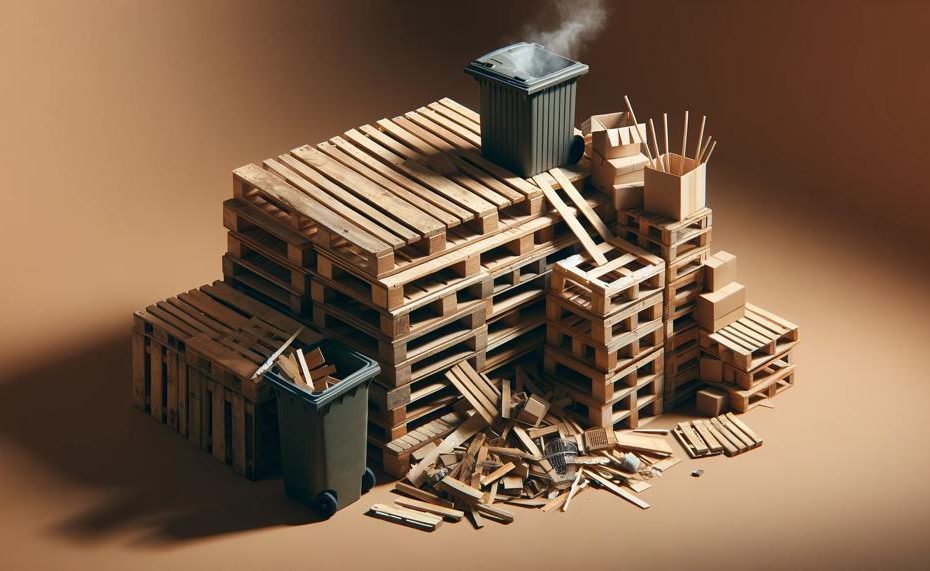Wooden pallets: they’re the unsung heroes of the shipping and storage industry, but what happens when they’ve served their purpose and are ready to retire? Disposing of wooden pallets can be more complex than just tossing them into a dumpster. Proper disposal is not only environmentally responsible but can also tap into their hidden value and potential for a second life.
In today’s post, we’re stripping back the layers on the humble wooden pallet and revealing the smart and sustainable ways to say goodbye to these wooden workhorses. Whether you’re a business owner with a stack of pallets to clear out, or a DIY enthusiast with a few leftover from your latest project, this article will guide you through the best practices for pallet disposal.
So, how to dispose of wooden pallets properly?
Wooden pallets can be recycled, repurposed, or disposed of by professional junk removal services. Recycling is the best way to dispose of pallets, as the wood can be used to make other products such as mulch, animal bedding, or new pallets. Pallet recyclers often collect used wood pallets to repair and sell them for reuse by other businesses. Pallets that are beyond repair may be mulched. Recyclers often pay a small amount per pallet for sizes that are in demand. Some manufacturers also offer refurbishing services.
Here are some ways to dispose of wooden pallets:
- Return programs: Return used pallets to the manufacturers to earn credits for new pallets.
- Donate: Donate pallets to a recycling facility.
- Sell: Pallets can be sold for competitive prices. The average price for wood pallets in like-new or good condition is $0.50 – $4 per pallet. Some companies may offer pick-up services.
- Compost: Pallets can be used to make compost bins, which can feed plants, improve soil condition, break up clay, and mulch plants.
Wooden pallets thrown into landfills can take years to decompose and may release chemicals or toxins into the soil and groundwater.
So, let’s get started.
Contents
Are Wooden Pallets Safe to Burn?
Burning wooden pallets is not a safe nor environmentally responsible method of disposal. The smoke released contains harmful chemicals, such as carbon monoxide and nitrogen oxides, which pose health risks and environmental harm.
Furthermore, many pallets are chemically treated, which, when burnt, can release additional toxic compounds into the air.

| Risks | Health Impact | Environmental Impact |
| Carbon Monoxide Emission | Respiratory issues, especially in vulnerable individuals | Contributes to greenhouse gas levels |
| Chemical Treatments | Potential release of additional toxins | Contamination of air, potential harm to plants/animals |
| Legal Consequences | N/A | Penalties due to violation of EPA regulations |
Pallets often end up in a limbo of disposal after their shipping life ends. If they’re stamped and in fine nick, they might find a second life in a DIY project or back in the transport loop. But if they’re dinged up and past their prime, recycling into mulch or other wood products is the way to go.
Tossing them into the flames isn’t just a slap in the face to Mother Nature; it’s often against the law, with fines to boot for those caught.
Proper disposal includes identifying pallet type, assessing for reuse or recycling, and consulting local waste management for any specific guidelines. Composting is an option for untreated wood, but remember to break those boards down to size before adding them to the heap.
To sum it up, burning wooden pallets is neither a clever nor a lawful choice.
How To Dispose Of Wood Pallets (Different Ways)
Disposing of wooden pallets properly is crucial for environmental conservation and abiding by legal requirements.
Recycling Pallets
Wooden pallets can be recycled and transformed into new items. Often, pallet recycling firms collect and refurbish them into furniture, garden mulch, or other wooden products.
Donating Pallets
Offering pallets to hobbyists, schools, or community groups for reuse in DIY projects or for educational purposes can be a beneficial way to repurpose them.
Composting Pallets
Pallets composed of untreated wood can be broken down and added to compost heaps, contributing carbon-rich materials to the composting process.
Landfill Disposal
As a last resort, disposing of pallets in landfills should be done neatly and in accordance with local regulations to avoid creating hazards.
Are wood pallets recyclable?
Yes, wood pallets are indeed recyclable and can be repurposed.
Recycling Wooden Pallets
Wood pallets are a staple in the transportation of goods globally, and their life cycle doesn’t end when the cargo is unloaded. These sturdy structures are ripe for a second life through recycling or repurposing.
Repurposing Ideas:
- Furniture: With simple tools, pallets transform into tables, bed frames, and shelves.
- Garden Projects: Pallets can be used to make planters or compost bins.
- Decor: Painted or stained, they become artful displays or practical coat racks.
Finding Pallets:
Pallets are often available at no cost from local businesses, particularly those in construction or logistics, who may be happy to see them reused rather than discarded.
Creative Reuse:
| Project | Tools Required | Potential Use |
| Coffee Table | Saw, Nails, Hammer | Living Room |
| Bookshelf | Saw, Nails, Screws, Drill | Study or Lounge |
| Garden Planter | Saw, Landscape Fabric, Staple Gun | Outdoor Spaces |
Decoration:
A dash of paint or some stencils, and your pallet project becomes a conversation piece, melding function with flair.
Why Recycle Pallets?
Recycling not only curbs environmental impact by reducing waste but also offers a creative outlet and the satisfaction of crafting something bespoke and useful. Plus, it’s a thrifty way to enhance your surroundings or even kick-start a hobby.
Remember, before starting your project, ensure the pallets are safe and free from chemicals or pests.
How to reuse wood pallets?
Wood pallets, those sturdy frames of timber used for hefting loads, can find new life beyond their shipping days. Here’s how to give them a second act:
Furniture Crafting
Transform pallets into unique pieces of furniture. Sand the wood, apply a finish if desired, and assemble into items like:
- Coffee tables
- Bookcases
- Desks
- Beds
Garden Projects
Pallets can be repurposed for the garden into:
- Vertical planters
- Compost bins
- Potting benches
- Raised garden beds
Home Decor
Create a rustic vibe in your home with pallet-derived decor:
- Wall art
- Shelving units
- Picture frames
- Wine racks
Outdoor Spaces
Enhance your outdoor area by crafting:
- Patio furniture
- Swings or hammocks
- Decking
- Bars
Storage Solutions
Organize your space with pallet-built storage:
- Shoe racks
- Wardrobes
- Tool racks
- Storage boxes
Flooring and Paneling
Reclaimed pallet wood can be used for:
- Hardwood flooring
- Wall paneling
- Ceiling designs
| Project Idea | Required Tools | Additional Materials |
| Bookshelf | Saw, Hammer, Nails | Wood glue, Sandpaper |
| Vertical Garden | Screwdriver, Landscaping fabric | Staple gun, Potting soil, Plants |
| Patio Bar | Drill, Screws | Varnish, Castor wheels |
Safety and Sourcing:
It’s ace to snag pallets for free or a snip, but you must pick safe ones. Look for the ‘HT’ (Heat Treated) stamp, shunning chemically treated kin. Swing by local shops, factories, or online marketplaces to find your timber trove.
Prepping Pallets:
Before crafting, pull out any rogue nails and give the wood a good scrub. A bit of sanding makes for a smoother surface, priming it for paint, stain, or sealant, should you wish.
Tutorials and Inspiration:
For those itching to start, a raft of bloggers and DIY enthusiasts share their step-by-step guides online. YouTube and Pinterest are also chockablock with ideas to spur your creativity.
Remember, when reusing pallets, you’re not just making something neat; you’re keeping wood out of the landfill and cutting down on the need for new resources.
Advantages of disposing of unwanted wood pallets:
Disposing of unwanted wood pallets properly boasts myriad benefits, spanning environmental, safety, financial, and operational domains. Here’s a breakdown of the key advantages:
Environmentally Responsible
Wood pallets cluttering landfills is an eyesore and an environmental misstep.
Proper disposal often means recycling or repurposing, which cuts down on waste and pollution, fostering a healthier planet.
Safety First
Timeworn or busted pallets are accidents waiting to happen. They could trip up staff or topple over. Clearing them out responsibly keeps everyone safe and sound.
Workspace Zen
A tidy workspace is a productive workspace. Offloading old pallets creates room to manoeuvre and a spotless, uncluttered environment where efficiency thrives.
Penny-wise
Believe it or not, chucking out old pallets can save a pretty penny. Recycle or upcycle them, and you’ll trim down on the costs of buying spanking new ones.
Community Role Model
By dealing with waste wisely, you’re setting a sterling example. It’s like saying, “Hey, let’s all be mindful of our rubbish,” nudging others towards sustainable practices.
Why are plastic pallets a better option?
Plastic pallets present a slew of advantages over their wooden counterparts, especially when it comes to hygiene, logistics, durability, and overall cost-effectiveness. Here’s a breakdown of the key benefits:
Hygiene
Plastic pallets are non-porous and can be easily sanitized, making them ideal for industries where cleanliness is paramount, such as food and pharmaceuticals.
| Aspect | Plastic Pallets | Wooden Pallets |
| Hygiene | Easy to clean and sanitize | Can absorb moisture and harbour bacteria |
| Durability | Longer lifespan, resistant to damage | Prone to splinters, warping, and decay |
| Logistics | Lightweight, reducing freight costs | Heavier, potentially increasing freight costs |
| Environmental Impact | Recyclable, less frequent replacement | Often single-use, can require treatment with chemicals |
When weighing up plastic against wooden pallets, one must gauge the needs of their specific industry, the nature of the goods being transported, and the frequency of shipments.
Conclusion
It’s evident from our exploration of the complex world of wooden pallet disposal that these durable platforms provide benefits beyond their original use. In addition to showing respect for the environment, properly disposing of wooden pallets may help find their hidden worth and prospective uses. We make major progress toward sustainability, resource conservation, and creativity in our everyday actions by recycling, reusing, or composting.
We’ve spoken about the risks associated with burning pallets and the need of following rules. Assessing each pallet’s condition and choosing the best disposal option—whether it’s a do-it-yourself effort or a trip to a recycling center—are crucial. We’ve also discovered that these wooden workhorses may be creatively transformed into lovely furniture, garden accents, or ornamental objects, enhancing our environments and lives while producing less trash.
In conclusion, appropriately disposing of wooden pallets demonstrates our dedication to the environment, security, and ingenuity. Let’s take on the duty of making sure that a pallet’s last chapter leaves as much of an impression as its first, leaving a legacy of sustainability and innovation for coming generations.





